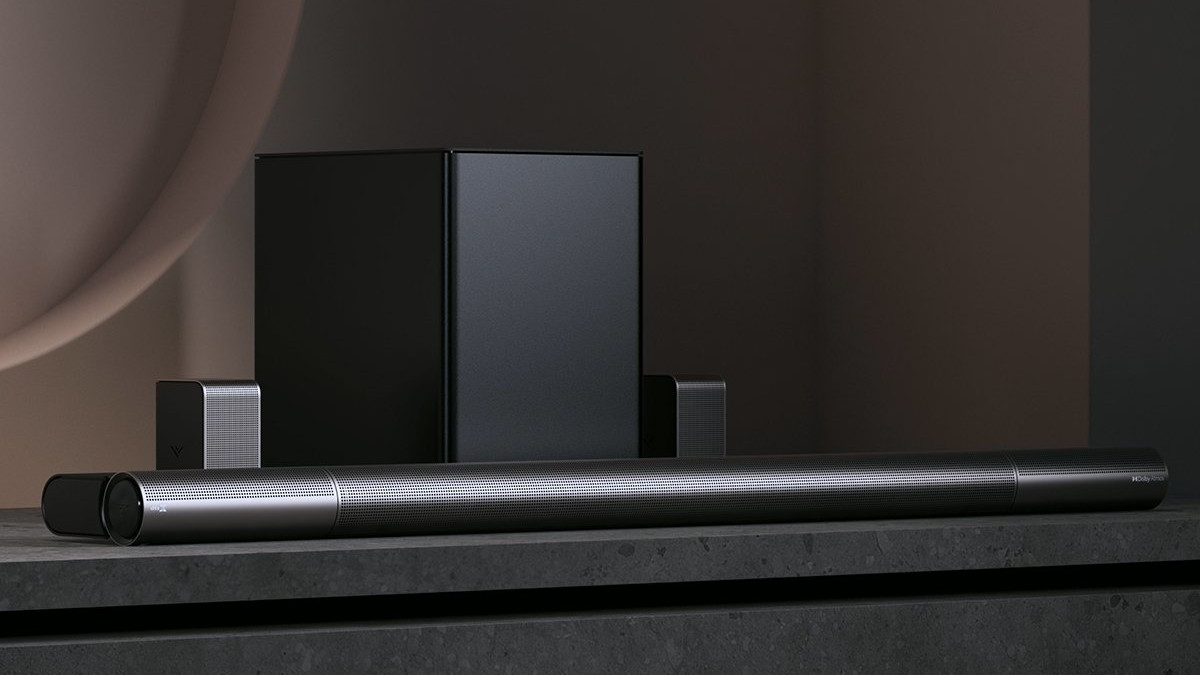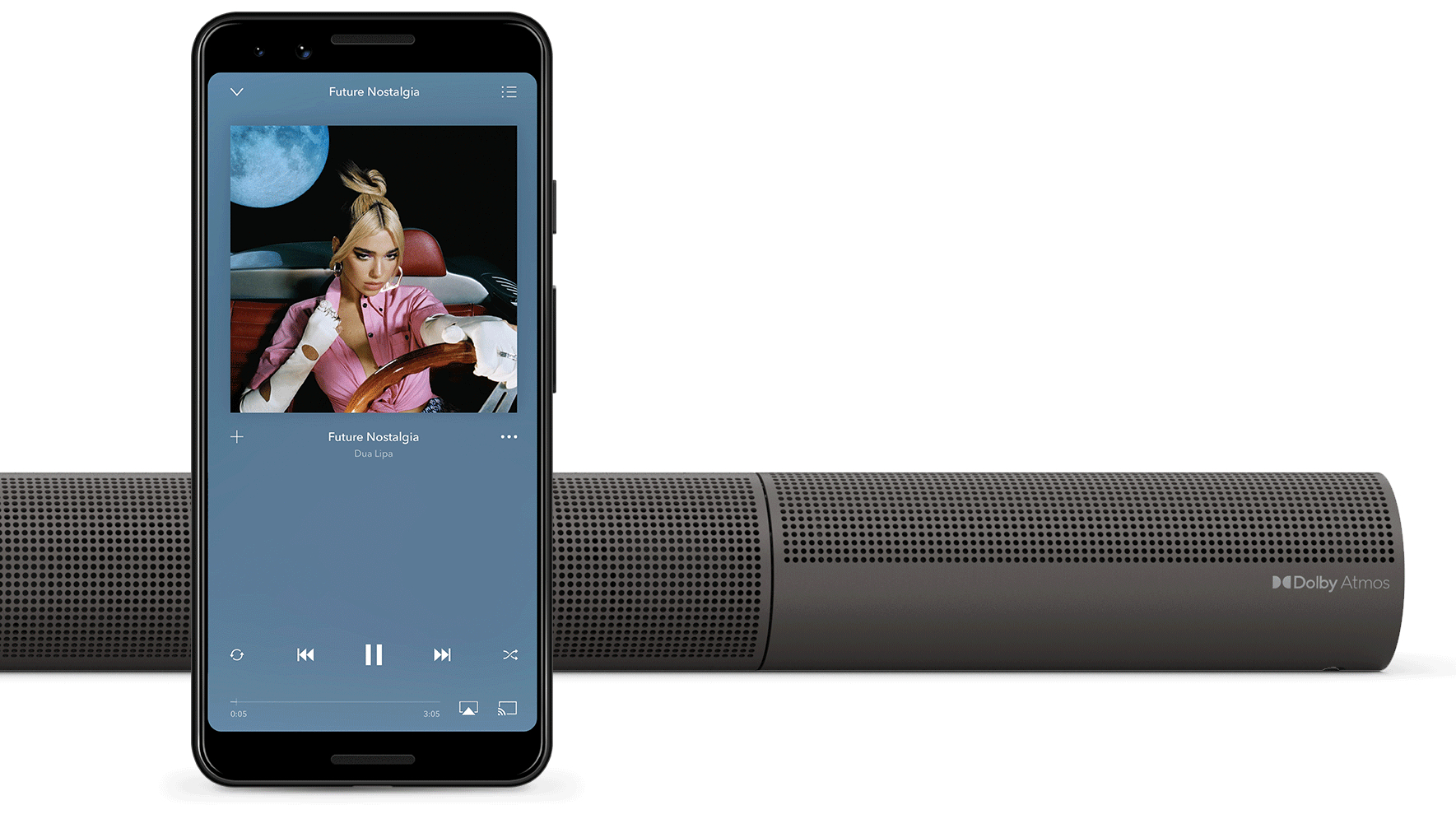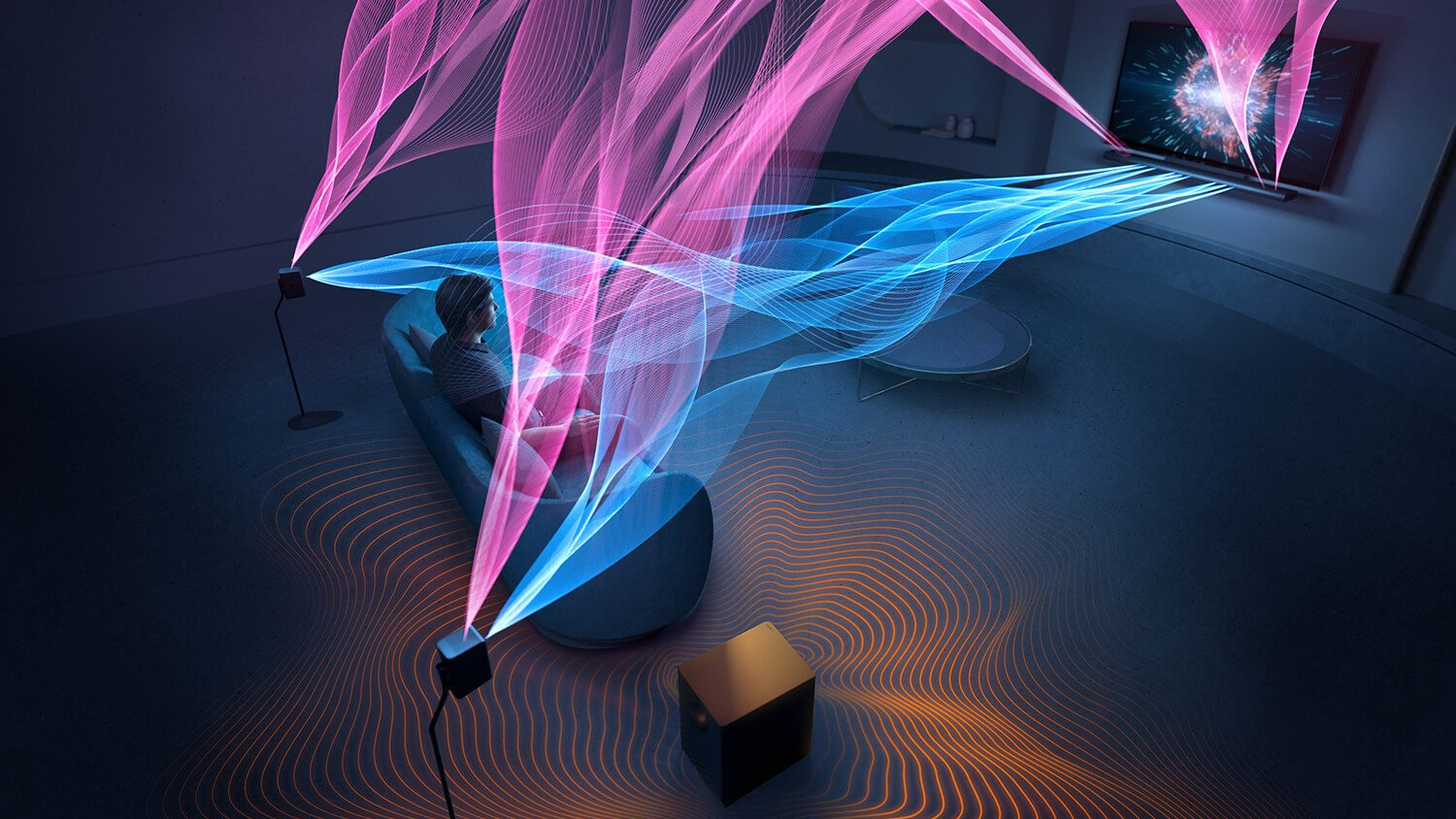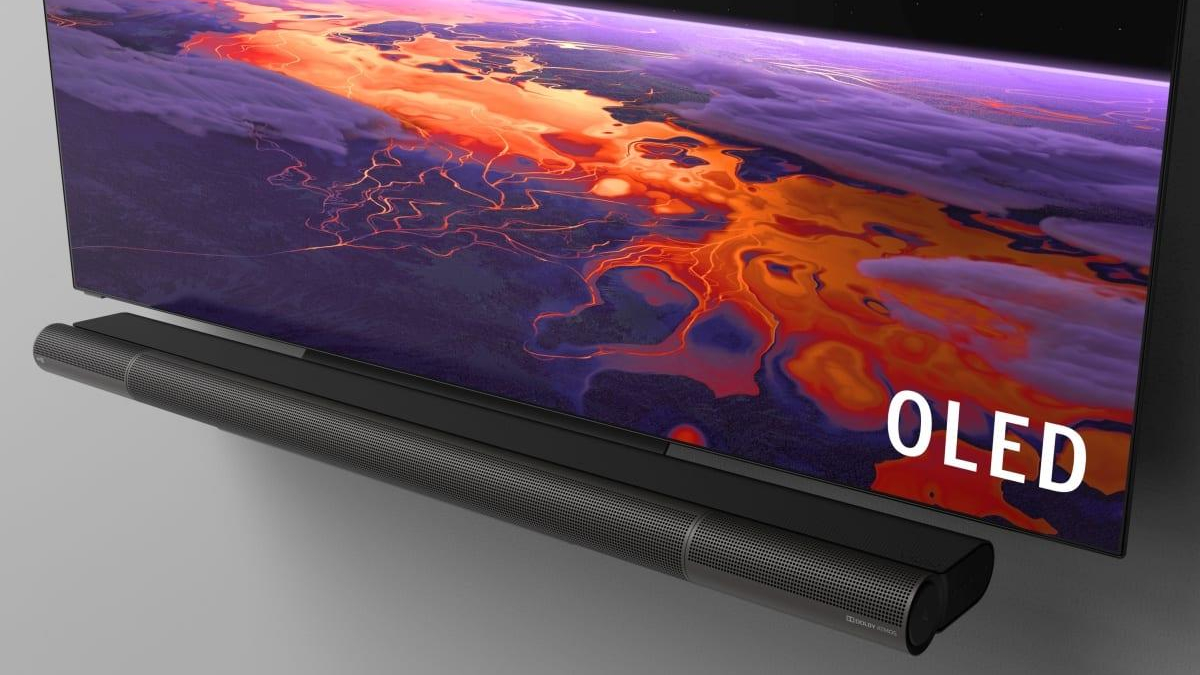Vizio Elevate Sound Bar
30-second review
If you like conversation-starting design, you’ll appreciate the Vizio Elevate Sound Bar. When it recognizes Dolby Atmos input, the side speakers physically rotate up revealing the Dolby Atmos logo before you’re immersed in a bubble of sound.
It’s a neat party trick, certainly, but it’s also an effective way to shift between a standard 5.1 surround sound soundbar with satellite speakers to a full fledged 5.1.4 Dolby Atmos system, all without having to install speakers in the ceiling to accommodate the extra channels.
The sound quality is a bit on the boomy sound with a heavy emphasis on rumbly bass and a lack of clarity in the upper registers but, if you want Dolby Atmos sound without having to buy a receiver, it’s a well-rounded alternative to some of the best soundbars from LG, Sony and Samsung.
Price and release date
The Vizio Elevate made its debut at CES 2020 and was released late last year. That said, you’re going to see this one on store shelves for awhile as Vizio will continue to put out the soundbar throughout the rest of the year.
In terms of price, you’re looking at $999 – around £700, AU$1,300, though not available in either territory right now – making it one of the more expensive soundbars on the market.
The Elevate comes with two satellite speakers and a wireless sub for the high asking price, but you can find similar systems for half the cost - like Vizio’s own SB46514-F6 that comes in at $599. Why you’re paying extra for the Elevate, essentially, is that it has rotating speakers and extra drivers in the soundbar that deliver a louder sound.
Of course, if you’re looking for both power and clarity – and don’t mind paying even more – we’d recommend looking at the Samsung HW-Q950T Soundbar or the LG SN11RG. They’re both more expensive and don’t rotate when they detect Dolby Atmos audio, but they offer better balanced sound. Still, the Vizio Elevate is a good offering worth considering if you've got a Vizio OLED.

Design
The Vizio Elevate certainly has a unique design: instead of being an all-black unibody bar, the Elevate incorporates rotating speakers on the sides. It’s still mostly an all-black unibody bar otherwise, but this little detail makes it stand out in a crowded field.
That said, to accommodate the rotating speakers, the body has a bit more depth than traditional soundbars have and measures in at a rather chunky 2.64 x 48 x 6.5 inches (H x W X D). It can still be wall-mounted despite the extra depth, and it will pair nicely should you decide to go for the Vizio OLED for which it was built for.
Inside, you’ll find a full array of drivers (18, according to Vizio) with about two drivers per channel. Those drivers are going to add to the power output but their close proximity to one another is what creates the confined sound.
So how do you get a wider soundstage? Well, that’s where the satellite speakers come in.
To power and drive the satellites you’ll run an included power/signal cable from the back of the subwoofer to each of the two satellites. They’re not wireless, unfortunately, but the proprietary power cables Vizio uses should be long enough to span any living room and the subwoofer, thankfully, is wireless.
Turn the ‘bar upside down and you’ll see the ports. Here you’ve got one HDMI-ARC port that connects to your TV and two HDMI-In ports that you can use to connect game consoles, Blu-ray players or streaming sticks. While HDMI-ARC is your best bet to connect to a TV – as it’s the only way to pass Dolby Digital data – you can also connect it via a 3.5mm auxiliary cable or optical audio, and it’s nice that the Elevate is flexible enough to support them all.
Last but not least, the Vizio Elevate comes with a basic plastic remote. The remote is nothing special in terms of build quality, but it does come with a screen that makes it easy to navigate menus and tweak the soundbars’ settings. We typically prefer GUIs for this stuff, but we appreciate how easy it was to enable things like Night Mode that reduces bass with just a few button presses.

Features
There’s not much in the way of extra features, sadly. Unfortunately this is really just a soundbar – there’s no built-in smart assistant or smart platform – so it just takes the audio you route to it and pumps it out.
While we can live without yet another smart assistant in our homes or another avenue to streaming services like Netflix and YouTube, not having features like auto-room calibration at a soundbar at this price point does feel like a big miss. Sure, you can go in and tweak the EQ yourself using a number of different presets, but auto-room calibration is something the Sonos Arc has for $200 less than the Vizio Elevate.
The good news? You may not get a built-in smart assistant here, but the Vizio Elevate is compatible with Alexa, Siri and Google Home, plus it comes with Chromecast Built-in if you simply want to throw on a song from your phone without getting any smart assistant involved.
The latter is nice if you want to throw on some music from your phone without having to deal with Bluetooth, while the former is a nice perk for folks who have a Google Nest Mini or Amazon Echo Dot.
Admittedly, it’s not as feature-rich as some of the competition, and at this price point that really hurts the value of the Elevate.

Performance
The good news is that, as a Dolby Atmos soundbar, the Vizio Elevate can really hold its own. With Atmos turned on and it firing at full blast, the Elevate is an immersive experience that puts you in the heart of the Amazon when watching Our Planet on Netflix or on the dusty, dangerous plains of the post-apocalyptic future in Mad Max: Fury Road.
In fact, anytime the soundbar was playing Dolby Atmos, we were very impressed. The mix could’ve had a bit more surround presence, but all things considered it was exactly how Dolby Atmos audio should sound.
The problem, unfortunately, is that when it comes to stereo or regular 5.1 surround sound, the Vizio Elevate just doesn’t do much to enhance the audio – it presents the audio tracks with a relatively flat sound that lacks a lot of detail.
That can be an issue when you want to get the most bang for your buck out of 5.1 Blu-rays or streaming movies, and it really makes games like Overwatch – that have a ton of details when using headphones – feel less immersive.
The Elevate also has an enormous amount of bass as well. That can be great when you want wall-shaking action sequences, but can be less enticing when you just want crisp, clear dialogue at night. Thankfully, there is a Night Mode that you can enable, but even in that mode there’s still way too much bass.
Music, on the other hand, has a bit of bass but a nice focus on the mids. You won’t get shimmering vocals in the upper registers, however, and sound will only play from the main soundbar unit and not the satellite speakers – so don’t expect a club-like atmosphere in your living room.
Finally, it’s not available on the Elevate, but it’d be nice if the soundbar could detect what kind of content is playing at any given moment and shift the EQ to match. This is one of the key features of Samsung’s lineup of soundbars, and unfortunately the Elevate doesn’t match it. You'll have to change the EQ any time you change from movies to music to games. Bummer.
Should you buy the Vizio Elevate Sound Bar?

Buy it if…
You want solid Dolby Atmos sound in a single box
If the idea of running spools of wire throughout your living room sounds like an exercise in frustration, the Vizio Elevate offers a simple and convenient Dolby Atmos experience.
You love showing off cutting-edge technology
Watching the rotating speakers turn up toward the ceiling when the soundbar detects a Dolby Atmos signal never gets old. It feels futuristic and will certainly impress your guests.
Don’t buy it if…
You want a feature-rich soundbar
Compared to another high-end soundbar like the Sonos Arc, the Vizio Elevate is definitely a bit sparse on the features front. It doesn’t have auto-calibration, nor does it come with any smart platform built in or a built-in smart assistant.
You’re after pristine sound with tons of clarity
Unfortunately the convenience of a soundbar comes at the expense of a more limited soundstage. Yes, you’ll get some solid 3D sound with Atmos turned on, but this isn’t the clearest or most immersive 5.1 surround sound system we’ve heard for the price.
- Looking for something cheaper? Don't miss our guide to the best cheap soundbar deals
0 comments:
Post a Comment